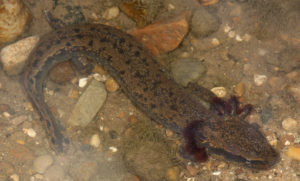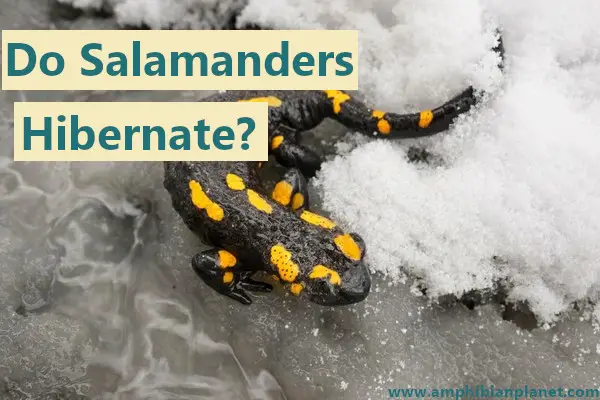Salamanders are ectothermic (cold-blooded) animals, which means they can’t generate their own internal body heat. Instead, their body temperature changes with that of their surroundings. Due to this, salamanders become less active in the winter when the temperatures drop.
Terrestrial salamanders hibernate in logs or underground burrows when their environment gets too cold. Many aquatic salamanders hibernate by burying themselves in the mud at the bottom of the water bodies they are in. Some salamanders such as the mudpuppy do not hibernate and are active all winter.
However, “hibernate” is a slightly inaccurate term. The correct term is “brumation”. Hibernation is a term reserved for warm-blooded (endothermic) animals such as squirrels. Brumation refers to almost the same thing but in cold-blooded animals.
Brumation vs Hibernation
Brumation is very similar to hibernation. In fact, many people use these two terms almost interchangeably. However, there are some differences between these two concepts.

Hibernation is when a warm-blooded animal voluntarily enters a state of dormancy to conserve energy and minimize the necessity to go out and forage for food.
This usually happens in the winter, when animals want to avoid the freezing temperatures, and food is harder to find. Think of it like going into a very deep sleep for an extended period.
Brumation, on the other hand, is when a cold-blooded animal enters an involuntary state of torpor (dormancy) when the temperature in its surroundings falls. Remember, cold-blooded animals such as salamanders cannot control their internal body temperature.
This means they can not suppress their metabolic rates and are forced into a state of dormancy when the temperature drops.
Another key difference is; brumating animals are easily disturbed and will be active on warm days. Even it happens in the dead of winter.
In contrast, most hibernating animals are not easily disturbed and will stay inactive for most of the winter.
However, despite the differences, I will stick with the well-known and generally understood term “hibernation” to keep things simple.
How Salamanders Prepare for Hibernation/Brumation
As winter approaches, salamanders instinctively know to start preparing for hibernation.
Most salamanders will start to eat more than normal, to put on good body weight before they enter hibernation. In some salamander species, such as the long-toed salamander, most of these extra proteins and fats are stored in the tail.
After bulking up, salamanders will voluntarily stop eating, become less active, and start to sleep a lot. This is usually just before the start of hibernation.
Terrestrial Salamanders Hibernate on Land
Since there are so many salamander species. The exact place a salamander will hibernate differs among different species.
Most terrestrial salamanders will hibernate in underground burrows, where the frost does not penetrate. Since they can’t dig their own burrows, they typically search for abandoned animal burrows or natural holes.

Some terrestrial salamanders may also hibernate in deep rock crevices, under rocks, logs, or under thick leaf litter on the ground.
The most important thing is that the hibernaculum (hibernating place) should be a place where the salamander will be shielded from extreme cold, and where the salamander won’t lose too much moisture through its skin.
Aquatic Salamanders Hibernate Underwater
Aquatic salamanders need to be in the water to thrive, so they will only hibernate in an aquatic environment.
However, not just any pond or stream will do. The pond needs to have a good amount of oxygen dissolved in the water, and not freeze the way to the bottom.
When it’s time to hibernate, the salamanders will typically go to the very bottom of the pond, where the water doesn’t freeze solid, and may partially bury themselves in the mud.
Once the water warms up, the salamanders will emerge from hibernation and become more active.
Some Aquatic Salamanders Stay Active Through the Winter

Although most salamanders hibernate, some aquatic salamanders such as the mudpuppy are most active during the winter. When the temperatures drop, they just travel to deeper water, where the water doesn’t freeze solid.
Hellbenders overwinter in fast-flowing streams that remain ice-free all winter. They are even known to breed during the winter.
However, most aquatic salamanders, even if active in the winter, will wait until spring to mate and lay their eggs.
For How Long Do Salamanders Hibernate?
Most salamanders can only hibernate for three to four months before they will have to get active again. If the temperatures drop and remain cold for extended periods, the salamanders will not survive.
However, some salamanders, such as the Siberian salamander, can “freeze up” and survive temperatures of as low as -50°F (-58°C) for several years. Even after such a long time, this salamander will revive and walk off when thawed out.
Still, a sudden drop in temperatures is a serious problem even for the Siberian salamander. It needs time to adapt to the cold and produce chemicals that protect its cells and tissues from ice damage.
When fully prepared the Siberian salamander can hibernate in this “frozen” state for over a decade. However, this is unusual so most salamanders won’t be able to hibernate that long. The majority of salamanders can only hibernate for a few months.
Spring Temperatures Bring Salamanders Out of Hibernation
When the snow starts to melt and the weather gets warmer, salamanders will emerge from hibernation. This is because their metabolic rates get high enough to allow them to be more active.
During this time, terrestrial salamanders will migrate to vernal pools and breeding ponds looking for mates. After mating, the female salamanders will lay dozens of jelly-covered eggs and attach them to grass and other vegetation in the breeding ponds.
After a few weeks, tiny larvae will hatch from these eggs, and live an entirely aquatic life until they go through a process known as metamorphosis and transform into young versions of the adults. These juvenile salamanders then leave the water, to live a mostly terrestrial life, only occasionally returning to the water.
Salamanders Sometimes “Hibernate” in the Summer
Freezing temperatures aren’t the only thing salamanders have to worry about. Being cold-blooded animals, high summer temperatures are just as undesirable as the cold.
To cope with high temperatures, salamanders such as the greater and lesser Siren estivate. Estivation (also called aestivation) is a type of dormancy similar to hibernation. The only difference is, hibernation happens in the winter, while estivation happens in the summer. Think of it like “summer hibernation”
To estivate, a salamander will retreat to a cool shaded area. Then, its heartbeat, breathing rate, and overall metabolic rate will dramatically decrease. This conserves energy and reduces the salamander’s need for food and water, during this period.
Some salamanders will also secrete mucus all over their skin. This mucus creates a protective cocoon and prevents the loss of moisture through the skin.
When the temperatures drop or the rain begins to fall, salamanders will emerge from estivation and be more active again.
Hibernation in Captive Salamanders
Salamanders only hibernate out of necessity. If a salamander is kept in a place with optimal temperatures, it does not need to hibernate. This means most pet or captive salamanders kept in a controlled environment do not need to hibernate.
However, if a captive salamander is not kept at a controlled temperature. It will enter a state of torpor and hibernate when the temperatures fall, just it would in the wild.
Signs that a captive salamander is preparing to hibernate include;
- Deep burrowing in its enclosure (some salamanders may simply hide under logs and other hiding spots in the enclosure for extended periods)
- Sleeping more frequently
- Very little appetite
In the wild, salamanders will come out of hibernation when the warmer spring temperatures arrive. However, in captivity, you can encourage your salamander to come out of hibernation by simply increasing the temperature and humidity levels in its enclosure.
What to Do if You Find a Hibernating Wild Salamander
If you find a hibernating salamander, it’s best to leave it alone. Do not touch it, pick it up, or move it to another location. Disturbing a hibernating salamander could cause it to prematurely come out of hibernation, which can be fatal to the animal.
However, if you have already disturbed the salamander, there are several things you can do to improve its chances of survival.
The first thing to do is to put it back where you found it. If you forget the exact place it was or are otherwise unable to put it back where you found it, place it somewhere where it will be protected from frost and predators such as cats or owls.
This could be in a log pile, in a compost heap, or any other safe area. The hibernaculum (hibernating place) you chose shouldn’t be warm, it should just be protected from the frost.
Frequently Asked Questions
Question: Can Salamanders Freeze to Death?
Answer: If the temperatures suddenly drop before salamanders can prepare for hibernation, they can freeze to death.
Also, if the temperatures get very low, and stay so for an extended period, even salamanders in hibernation can freeze to death.
For this reason, many salamanders do not make it through the winter, even with their ability to hibernate/brumate.
Question: What Does a Hibernating Salamander Look Like?
Answer: A hibernating salamander may look dead and won’t move at all. Its body will be cold to the touch, and it may even have a protective mucus sack covering its body
Final Thoughts
Most salamanders can survive the winter by hibernating in places that are protected from the frost. In the summer, they estivate to cope with extremely high temperatures.
Some aquatic salamanders such as the mudpuppy do not hibernate and are active under the ice of frozen ponds all winter long. In fact, mudpuppies have shown to prefer cold water to warm water when given a choice in lab experiments.
Salamanders in captivity do not need to hibernate if they are kept in a controlled environment. However, they can hibernate just like they would in the wild if the temperatures get low enough.
If you find a hibernating salamander, you best leave it alone! When the warmer spring temperatures come, it will wake from hibernation and walk out of its hibernating spot all on its own.


